Lake Mashū
Lake Mashū (摩周湖, Mashū-ko) (Ainu: Kamuy-to) is an endorheic crater lake formed in the caldera of a potentially active volcano. It is located in Akan National Park on the island of Hokkaidō, Japan. The lake has been called the clearest lake in the world.
| Lake Mashū 摩周湖 | |
|---|---|
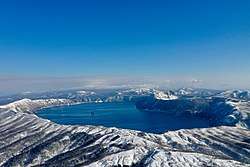 Lake Mashū, Japan, during winter | |
 Lake Mashū 摩周湖 | |
| Location | Teshikaga, Hokkaidō, Japan |
| Coordinates | 43°35′N 144°31′E |
| Type | crater lake, endorheic |
| Primary inflows | two streams |
| Primary outflows | seepage |
| Catchment area | 32.4 km2 (12.5 sq mi) |
| Basin countries | Japan |
| Max. width | 6 km (3.7 mi) |
| Surface area | 19 km2 (4,700 acres) |
| Average depth | 137.5 m (451 ft) |
| Max. depth | 211.5 m (694 ft) |
| Water volume | 2.86 km3 (0.69 cu mi) |
| Shore length1 | 19.8 km (12.3 mi) |
| Surface elevation | 351 m (1,152 ft) |
| Frozen | December to April |
| Islands | Kamuishu Island |
| Settlements | none |
| 1 Shore length is not a well-defined measure. | |
Hydrology
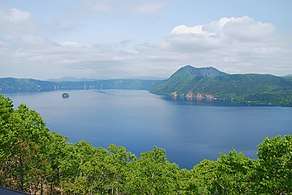

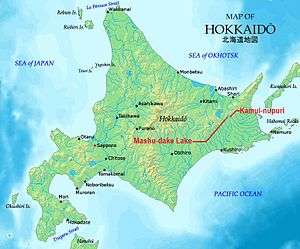
Lake Mashū is surrounded by steep crater walls 200 metres (660 ft) high. It has no significant inlets[1] and no outlet. The lake is one of the clearest in the world and one of the deepest in Japan.[2] On August 1, 1931 the transparency of the water was measured at 41.6 metres (136 ft). Around the same time Lake Baikal was measured 40.5 metres (133 ft). This is the basis for the lake's claim to be the clearest in the world.[1] Since the 1950s the transparency has tended to range between 20 and 30 metres (66 and 98 ft).[3] The loss in transparency is probably due to the introduction of sockeye salmon and rainbow trout into the lake and landslides.[4] At the same time, the clarity of Lake Baikal has not been measured.[5]
In summer, the surface of Lake Mashū is often obscured by fog. This has given the lake a reputation for mysteriousness.[6] A local legend says that if you can see the surface of the lake, you will have bad luck.[5]
Origin of the name
Lake Mashū was originally named Lake of the Devil by the Ainu.[6] This was rendered as Lake Mashin (魔神湖, Mashin-ko) by the Japanese. Over time, however, the Japanese began to refer to the lake by the Japanese reading for the neighboring peak, Mount Mashū (摩周岳, Mashū-dake).[7] The kanji for this peak translate roughly as scrubbed area mountain. The Ainu name for this peak, by which it is commonly known today, is Kamuinupuri or mountain of the gods. The lake also retains its Ainu name, Kamuito or lake of the gods.
Volcanic caldera
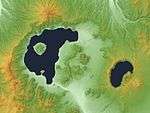
Mashū formed less than 32,000 years ago. The caldera is the remains of a stratovolcano, which is actually a parasitic cone of the larger Lake Kussharo caldera.[6] The eruption that created the current caldera occurred around 7,000 years ago. The last eruption was a plinian eruption about 2,000 years ago that dropped pumice over the region.
Mashū volcano is rated with a Volcanic Explosivity Index of 6, the second highest among large volcanoes.[8]
Two volcanoes have grown out of the Mashū caldera. Kamuishu Island, a lava dome which rises from the middle of the lake, is one. The other is Mount Kamui, a stratovolcano with lava dome, which forms the highest point on the eastern shore. A third volcano neighbors Kamuinupuri. It is Mount Nishibetsu. Mount Nishibetsu probably predates the caldera.
The main rock type of the volcanoes is andesite and dacite. The rock is non-alkali pyroclastic flow or mafic rock, dating from the Late Pleistocene to the Holocene. Some rock around the Mashū crater and Mount Nishibetsu is older still, dating from the Middle Pleistocene.[9]
The following table lists the eruptions of the Mashū volcano and Kamuinupuri.[10]
| Volcano | Date of eruption | Dating technique | VEI | Tephra volume | Type |
|---|---|---|---|---|---|
| Mashū | 7400 BC ± 200 years | Corrected radiocarbon | 4 | 440,000,000 cubic metres (0.11 cu mi) | Explosive eruption |
| Mashū | 6600 BC ± 50 years | Corrected radiocarbon | 6 | 11,000,000,000 cubic metres (2.6 cu mi) | Explosive eruption of the central vent with pyroclastic flow and caldera collapse |
| Mount Kamui | 2750 BC ± 100 years | Corrected radiocarbon | Explosive eruption of a flank vent | ||
| Mount Kamui | 1400 BC ± 100 years | Corrected radiocarbon | Explosive eruption of a flank vent | ||
| Mount Kamui | 100 BC ± 500 years | Tephrochronology | Explosive eruption | ||
| Mount Kamui | 300 AD ± 75 years | Corrected radiocarbon | Explosive eruption | ||
| Mount Kamui | 970 AD ± 100 years | Uncorrected radiocarbon | 5 | 1,000,000,000 cubic metres (0.24 cu mi) | Explosive eruption of a flank vent and caldera collapse |
Flora and fauna
The lake is inhabited by phytoplankton and zooplankton.
Sockeye salmon and rainbow trout have been introduced to the lake.
On the slopes around and above the lake grow a mixture of evergreen forest with Picea jezoensis and Abies sachalinensis and birch forest with Betula ermanii.
Economy
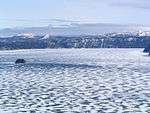
The Mashu-dake Hiking Course is a trail that goes along the crater rim and to the top of Mount Mashū.[2] There are no settlements along the shores of the lake. Access to the lakeshore itself is prohibited by the Ministry of the Environment (Japan). Visitors may only view the lake from the designated observation towers.[1]
See also
References
- "MASHU-KO (LAKE MASHU)". World Lakes Database. International Lake Environment Committee. Archived from the original on 2012-02-29. Retrieved 2008-10-15.
- Bisignani, J. D. (December 1993). "Doto~Eastern Hokkaido". In Taran March (ed.). Japan Handbook (Second ed.). Chico, California: Moon Publications, Inc. pp. 805–807. ISBN 0-918373-70-0.
- "GEMS/Water 摩周湖モニタリングデータブック" (PDF) (in Japanese). Center for Global Environmental Research. September 2004. ISSN 1341-4356. Cite journal requires
|journal=(help) - NHK World HD Channel
- "Lake Mashu". Highlights: Eastern Hokkaido. Akan Tourism Association & Community Development Promotion Organization. Retrieved 2008-10-15.
- Hunt, Paul (1988). "32. Climbing an Active Volcano: Meakan-dake". Hiking in Japan: An Adventurer's Guide to the Mountain Trails (First ed.). New York and Tokyo: Kodansha International. pp. 195–200. ISBN 0-87011-893-5.
- Akagi Sanpei (赤木 三兵), Journey of Hokkaidō Place Names—Notes on Ainu Language Place Names (北海道 地名の旅—アイヌ語地名解, Hokkaidō Chimei no Tabi — Ainugo Chimei Kai), page 128, (in Japanese).
- "Large Volcano Explocivity Index". Retrieved 2011-03-08.
- "Hokkaido". Seamless Digital Geological Map of Japan. Geological Survey of Japan, AIST. 2007. Retrieved 2010-09-28.
- "Mashu: Eruptive History". Global Volcanism Program. Smithsonian Institution. Retrieved 2020-03-23.
External links
| Wikimedia Commons has media related to Lake Mashū. |
- Mashu - Japan Meteorological Agency (in Japanese)
- "Mashu: National catalogue of the active volcanoes in Japan" (PDF). - Japan Meteorological Agency
- Mashu - Geological Survey of Japan
- Mashu: Global Volcanism Program - Smithsonian Institution
- Teshikaga Navi - Teshikaga Town